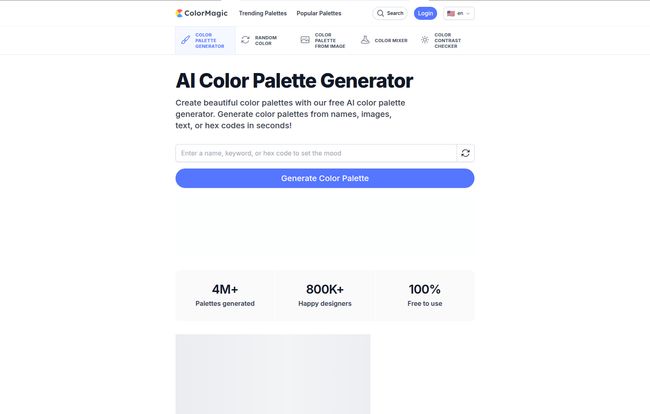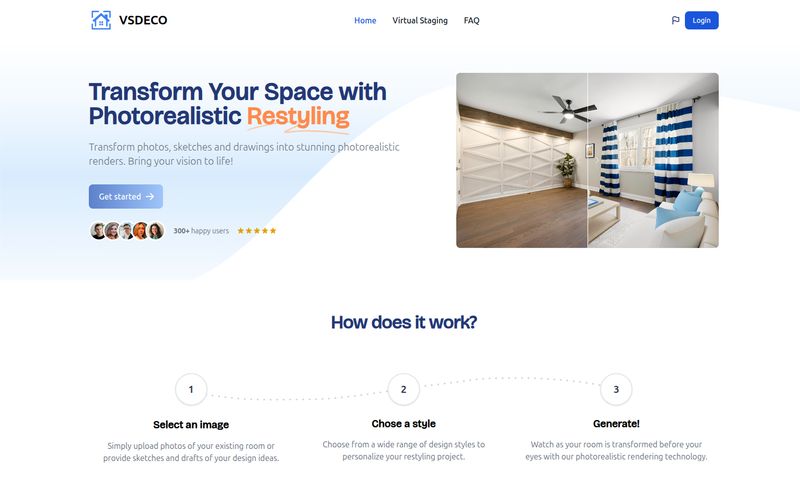We’ve all been there. Staring at a blank Figma canvas, a new WordPress install, or a slide deck that looks… beige. You know you need the perfect color scheme to make it pop, but your brain has officially left the building. You scroll through Dribbble for an hour, then Adobe Color, then back to Dribbble. This, my friends, is what I call “color-picking paralysis,” and it’s a productivity killer.
For years, the solution has been the same: just keep looking until inspiration strikes. But with the whole world going bonkers for AI, I started to wonder… could a robot be my color-picking muse? That’s what led me down the rabbit hole to a nifty little tool called ColorMagic. And honestly? I'm kind of impressed.
What Exactly is ColorMagic?
At its core, ColorMagic is a free AI-powered color palette generator. It’s not just another random hex code spinner, though. The secret sauce is that it uses AI (specifically GPT-3, for the nerds in the room) to interpret your words and generate a color palette based on a vibe, a theme, or a feeling. You can literally type in “a moody Wes Anderson film” and see what it cooks up. Pretty cool, right?
It also does the more standard stuff, like pulling a palette from an image you upload. But the text-to-color feature is what really caught my eye. It’s one thing to match existing colors; it’s another to create them from a pure concept.
Putting the "Magic" to the Test: My First Impressions
Okay, so talk is one thing, but how does it actually perform? I decided to take it for a spin, and the interface is incredibly straightforward. No clutter, no confusing menus. Just a big prompt bar daring you to challenge it.
Generating a Palette from a Whim
For my first test, I decided to give it something abstract. I typed in “the feeling of the first warm day of spring.”

Visit ColorMagic
What it came back with was… surprisingly good. A soft robin's egg blue, a pale daffodil yellow, a fresh leafy green, and a warm, earthy brown. It wasn't just a random assortment; it genuinely felt cohesive and matched the prompt. I tried a few more: “cyberpunk city at midnight” gave me neon pinks, electric blues, and deep, inky purples. “Vintage bookstore smell” returned a lovely set of muted browns, creamy paper tones, and a distinguished burgundy.
Now, is it perfect every time? No. Sometimes the AI gives you something a bit… creatively abstract. I once asked for a “pirate sea shanty” and got a palette that looked more like a 7-Eleven slushie machine. But even the misses are interesting and can sometimes spark an unexpected idea. It's less of a precise science and more of a creative partner.
Pulling Colors from an Image
This feature is more of a known quantity in the design world, but ColorMagic handles it well. I uploaded a photo from a recent hiking trip—lots of deep greens, grey rocks, and a bright blue sky. It instantly pulled the five most dominant and complementary colors, gave me the hex codes, and that was that. It’s fast, efficient, and does exactly what you expect it to do. No complaints here.
Beyond the AI: What Else is in the Toolbox?
While the AI generator is the main event, ColorMagic has a few other handy tools tucked away that are definately worth mentioning. I was pleasantly surprised to find a whole suite of freebies on their site.
There's a Color Mixer, which lets you blend two colors to see the result, like being a digital paint chemist. Super useful for finding those perfect 'in-between' shades. And for my fellow web developers, the CSS Gradient Generator is a godsend. It provides a simple visual interface for creating beautiful gradients and spits out the CSS code, ready to copy and paste. I've already bookmarked that one.
They also have a whole library of pre-made palettes, from 80s Color Palettes to Japanese Color Palettes. This is fantastic for when you're truly stumped and just need to see something that works, fast.
The Good, The Bad, and The... Free?
So, after playing around for a while, here's my honest breakdown. No tool is perfect, but this one gets a lot right.
What I absolutely love is the sheer speed and creative potential. It's a fantastic sparkplug for breaking through that initial design inertia. And the biggest pro of all? The price. It’s 100% free to use. In an industry where every great tool seems to have a subscription attached, you just can't argue with free. The social proof on their site—over 4 million palettes generated—tells me I'm not the only one who finds this useful.
"ColorMagic is changing the game for finding palettes. Instead of endlessly scrolling through pre-made ones, I can now ask an AI to find it for me..." – A user on ProductHunt.com
On the flip side, there are a couple of minor annoyances. To save a palette to your account, you have to log in. It’s a small bit of friction that I wish wasn't there. I'm a big fan of tools that just work without demanding my email address first. Also, as mentioned, the AI can be a bit of a wild card. If you need a very specific, brand-compliant color scheme, you’re still better off building it manually. This is more for exploration and inspiration.
So, Who Is ColorMagic Actually For?
I don't see this replacing a senior designer's finely-honed sense of color theory or a massive enterprise tool like Adobe Color. But that's not the point. ColorMagic is the perfect sidekick for a huge range of people:
- Web and UI Designers needing quick color ideas for mockups.
- Social Media Managers trying to create a cohesive look for an Instagram feed.
- Students and Indie Developers working on projects with a non-existent budget.
- Presenters who want their slides to look less like a 1998 corporate template.
- Anyone who just wants to play with color and find some new combinations.
It's a nimble, fun, and genuinely helpful tool for the early stages of the creative process.
Frequently Asked Questions about ColorMagic
- Is ColorMagic really free?
- Yes, according to their website, it is 100% free to use. You can generate as many palettes as you want without paying a dime.
- How does the AI color palette generator work?
- It uses a powerful AI language model (GPT-3) to understand the 'mood' or 'theme' of the text you enter. It then translates that concept into a matching and harmonious color palette.
- Can I use the palettes for commercial projects?
- Generally, color palettes themselves aren't subject to copyright, so you should be free to use them. However, it's always a good practice to review the terms of service on any platform, just to be safe.
- Do I need to sign up to use ColorMagic?
- No, you can generate palettes anonymously. You only need to create a free account if you want to save your favorite palettes for later use.
- How is this different from a tool like Coolors?
- While both are excellent palette generators, ColorMagic's key differentiator is its ability to generate palettes from descriptive text using AI, which is a unique approach compared to the more traditional spacebar-to-generate method of Coolors.
- Can I export the palettes?
- Yes! You can easily copy the hex codes for each color, copy the CSS for gradients, or download the entire palette as a PNG file, which is super convenient.
The Final Verdict: Is It Worth Your Time?
Absolutely. Look, ColorMagic isn't going to do your job for you. It won't replace a deep understanding of color theory or the careful consideration that goes into building a brand's visual identity. But that's not its purpose.
Its purpose is to be a jolt of inspiration. A way to break out of your creative rut. A fun, fast, and frictionless way to explore new visual ideas. For a free tool, it packs a surprising punch and has earned a permanent spot in my design toolbox.
So next time you're staring at that beige canvas, give it a try. Go play with it. Seriously. What have you got to lose?



